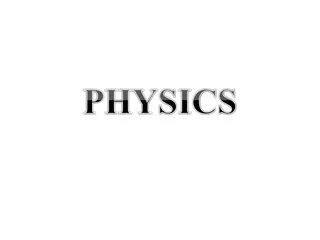Understanding Mechanical Equilibrium in Physics
Mechanical equilibrium is a critical concept in physics where an object experiences no physical changes when the net force on it is zero. This state is described mathematically by the equilibrium rule, stating that the sum of forces acting on an object is equal to zero. In scenarios like a gymnast hanging from two rings, the balance of forces determines the stability of the system.
Download Presentation

Please find below an Image/Link to download the presentation.
The content on the website is provided AS IS for your information and personal use only. It may not be sold, licensed, or shared on other websites without obtaining consent from the author. Download presentation by click this link. If you encounter any issues during the download, it is possible that the publisher has removed the file from their server.
E N D
Presentation Transcript
2.2 MECHANICAL EQUILIBRIUM
MECHANICAL EQUILIBRIUM You can express the equilibrium rule mathematically as: F = 0.
Mechanical equilibrium is a state wherein no physical changes occur. Whenever the net force on an object is zero, the object is in mechanical equilibrium this is known as the equilibrium rule.
The symbol stands for the sum of. Fstands for forces. For a suspended object at rest, the forces acting upward on the object must be balanced by other forces acting downward. The vector sum equals zero.
2.2 Mechanical Equilibrium The sum of the upward vectors equals the sum of the downward vectors. F = 0, and the scaffold is in equilibrium.
2.2 Mechanical Equilibrium The sum of the upward vectors equals the sum of the downward vectors. F = 0, and the scaffold is in equilibrium.
2.2 Mechanical Equilibrium The sum of the upward vectors equals the sum of the downward vectors. F = 0, and the scaffold is in equilibrium.
2.2 Mechanical Equilibrium The sum of the upward vectors equals the sum of the downward vectors. F = 0, and the scaffold is in equilibrium.
think! If the gymnasthangs with her weight evenly divided between the two rings, how would scale readings in both supporting ropes compare with her weight? Suppose she hangs with slightly more of her weight supported by the left ring. How would a scale on the right read?
2.2 Mechanical Equilibrium think! If the gymnasthangs with her weight evenly divided between the two rings, how would scale readings in both supporting ropes compare with her weight? Suppose she hangs with slightly more of her weight supported by the left ring. How would a scale on the right read? Answer:In the first case, the reading on each scale will be half her weight. In the second case, when more of her weight is supported by the left ring, the reading on the right reduces to less than half her weight. The sum of the scale readings always equals her weight.























